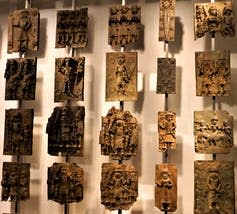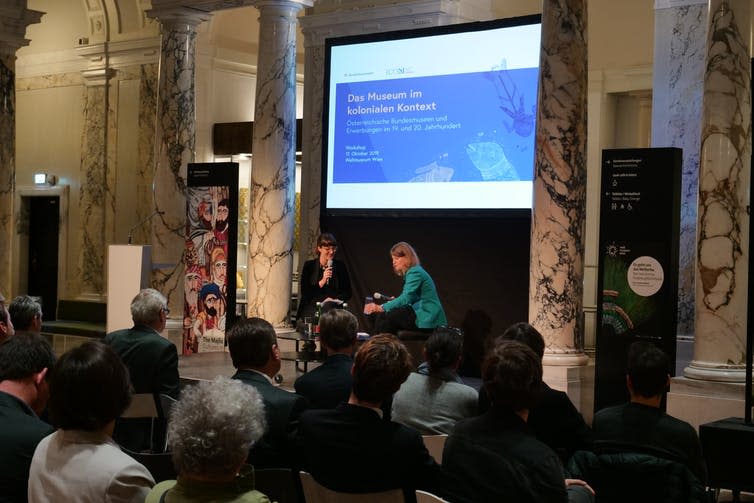Making kin not cash: repatriations of substance cannot be made on terms that solely suit European museums
Jesus College Cambridge announced that it will return a bronze to Benin, which was looted by British forces in 1897. As more institutions engage with repatriation, we have to interrogate its value and explore what other systems of relations and artistic production we can learn in the process.
For those who view repatriated artworks as an extension of their identity, treating them like investments – reducing ownership claims to purely political and financial motivations – is ludicrous. I saw this first hand in September when I accompanied the return of Maori artworks to Gisborne, New Zealand. With me was Jody Toroa, whose face expressed this absurdity as we discussed the evaluation of cultural treasures from her Maori ancestors.
Random insurance amounts, that are far beyond market values for such “tribal arts”, are put on pieces before they travel home as part of current repatriations. But these monetary values are soon irrelevant when they return to a context of personal relationships and customary use.
“Have you read about these Taonga (returning collections of cultural treasures)?” an elder asked me at the ceremonial return in September of material from the UK to New Zealand. “Yes, have you?”, I said. As a filmmaker and researcher, I am accompanying this process to make a longer version of Te Haa Kui o Tangaroa, a film about the knowledge regained from pre-colonial artistic practises and environmental management. She smiled and replied, “They are me.”
In other words, the Taonga are part of her. When the cloak that Tupaia, the Tahitian star navigator aboard the Endeavour in 1769, collected from Maori is worn, the wearer says to me: “They (the ancestors) are all here.”
Although the UK has one of the strongest diaspora voices for repatriation, the retentionist policies of the country’s major museums have been buttressed by the inalienability of national patrimony – a legal ban on giving possessions up permanently. But this law can be changed – Tony Blair promised it in 2000 , as did Jeremy Corbyn in 2018.
In France, a clear statement of support for the change of that country’s law of patrimony was made in 2017 and was followed with an executable report (Sarr and Savoy). This order is now forcing other nations to respond in kind.
Some recent repatriations to Africa (the Witbooi bible and whip from Stuttgart museum to Namibia, for example) are instructive of an ill-informed process. These cases prove the importance of taking time. There is a tendency for the powerful owners of cultural property and capital to try to use repatriation for their own ends. This, in turn, undermines the difficult processes of decolonisation that indigenous people are undertaking globally.
Relationship building
Repatriations cannot be made solely on the terms and timeframes that suit European political whims. This often doesn’t allow enough support to prepare the conditions for their arrival, particularly in the Witbooi and Maori cases cited, or to find agreement among the various potential recipient parties.
In turn, this has led to intensified tension between groups that were disrupted by their territory being carved up during colonisation. As a result, for example in Aotearoa/New Zealand, the “original owners” have since been divided by colonial governance structures into different groups and territories. As such, each now has its own leaders, makes it own treaty agreements and thus, has different political stakes in the return of particular cultural treasures.
The returning Taonga, which show within their designs their shared past ownership, also destabilised the complex web of familial, tribal, government and lobby interests of the present – a web that did not exist at the time of the looting. This is why a considered approach based on ethical motives and research, paired with a respect for the time and processes needed at the receiving end, is essential for successful repatriations.
The long-term Benin Dialogues, though, offer a precedent for solid relationship building.

The Benin Dialogues were started in 2010 between Barbara Plankensteiner of the Vienna Ethnographic Museum and the Nigerian Museums association. As Plankensteiner stressed in a panel discussion we recently held in Vienna, despite the often criticised amount of time taken, there are concrete results and a trust and conciliation process that require that timeframe.

The moves from the smaller private collections, like Jesus College Cambridge, as well as larger institutions, like the Quai Branly in Paris, to repatriate to Benin City should work with the new Royal Museum in Benin City project. They should seek to bolster the relationships that have been built around it.
Until Manchester Museum announced its “unconditional repatriation” of 42 Aboriginal items from their collection in October, English museums had been clinging to the “long-term loan” format. At best, the format ties both parties into a relationship, while avoiding changing the law of inalienability.
It’s a relationship that maintains the responsibility of European institutions to support recipient communities. This, in turn, helps to avoid the quick publicity of conciliation and atonement of colonial guilt that can leave communities even more fraught.
Hiding controversial collections
In time, an equivalent of the Washington Principles (guidelines for the repatriation of Second World War loot) would solidify this agreement. But European nations are far from the legal and political readiness, which took almost half a century, to create such principles.
Although contested, the comparison is striking. Repatriation to Holocaust victims provides a legal framework, memorial culture, and public identification with suffering. This legal system for repatriation, and the attendant recognition of guilt and responsibility, brings with it an ethical response to claims being made.
A recent conference on German and American perspectives on provenance research of the colonial and Nazi eras was among the first to openly discuss the comparison’s potentials. This level of awareness of the different forms of ongoing profit from colonialism, injustice and the deep grievance it causes, is part of the symbolic value of repatriation.
I’ve witnessed first-hand the emotional work of healing the colonial wound through cultural artefacts, not to mention human remains. When they return home, there is not a sense of political or economic victory. Rather, the occasion is accompanied by ceremonies akin to funerals. It is these new forms of kinship and the returns they inspire that are the potential of repatriation movements in the future.
This article is republished from The Conversation under a Creative Commons license. Read the original article.

Prof. Khadija von Zinnenburg Carroll has received funding for this work from TB21-Academy and the Sackler-Caird at Royal Museum's Greenwich. She works for The University of Birmingham.

 Yahoo News
Yahoo News 
